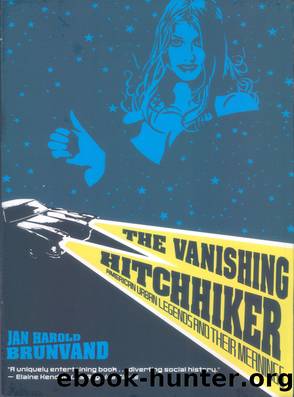The Vanishing Hitchhiker: American Urban Legends and Their Meanings by Jan Harold Brunvand

Author:Jan Harold Brunvand [Brunvand, Jan Harold]
Language: eng
Format: mobi, azw3
Publisher: W. W. Norton & Company
Published: 2020-08-03T16:00:00+00:00
NOTES
“The Spider in the Hairdo”
Gail Parent’s feature “Folklore from the Fifties” containing the quoted text of “The Spider in the Hairdo” appeared in Esquire , March 1976, pp. 76–77. Barre Toelken discussed this and other urban legends in “The Folklore of Academe” which is Appendix B in Jan Harold Brunvand, The Study of American Folklore , 2nd. ed. (New York: W. W. Norton, 1978), pp. 372–390, an essay first published in 1968; the quotation in this chapter appears on p. 377. My students Laura Fife and DeeAnne Ward gave me their versions of the legend, and their comments on them in Fall 1971.
The version from the University of Maryland is in George G. Carey’s Maryland Folk Legends and Folk Songs (Cambridge, Maryland: Tidewater Publishers, 1971), p. 87. Shirley Marchalonis discussed the medieval exempla in her article “Three Medieval Tales and their Modern American Analogues,” Journal of the Folklore Institute , 13 (1976), 173–184, reprinted in Jan Harold Brunvand, ed., Readings in American Folklore (New York: W. W. Norton, 1979), pp. 267–278. She quoted the passage given in this chapter from G. R. Owst, Preaching in Medieval England (1926) on p. 268 in the reprint.
Perutz’s Beyond the Looking Glass (New York: Wm. Morrow, 1970) has the spider story on p. 308. It was reprinted in the consumer newsletter Moneysworth on October 4, 1971, according to Ronald L. Baker in “The Influence of Mass Culture on Modern Legends,” Southern Folklore Quarterly , 40 (1976), 372.
Kenneth Clarke’s interpretation appeared as “The Fatal Hairdo and the Emperor’s New Clothes Revisited,” Western Folklore , 23 (1964), 249–252.
“The Kentucky Fried Rat”
George G. Carey’s traditional version of “The Kentucky Fried Rat” appeared on page 71 of his Maryland Folk Legends and Folk Songs (Cambridge, Maryland: Tidewater Publishers, 1971). On pages 72 to 73 of the same book Carey reprinted the Washington Post story about the mouse parts in the Coca-Cola bottle. Various notes and queries in the British folklore journal Lore and Language from 1972 to 1978 have described rat-bone stories about restaurants both in Great Britain and on the Continent. The Rhodes-rat story from Dagens Nyheter headlined “Rattben i halsen” [Rat bone in the Throat] was sent by Ingemar Liman of Stockholm to Louie W. Attebery, College of Idaho, Caldwell, who then kindly lent it to me. Donald Ward’s discussion of “The Kentucky Fried Rat” appears in his article “American and European Narratives as Socio-Psychological Indicators,” in Folk Narrative Research: Some Papers Presented at the VI Congress of the International Society for Folk Narrative Research , Juha Pentikainen and Tuula Juuvikka, ed., Studia Fennica , 20 (Helsinki, 1976), 348–353. Gary Alan Fine kindly sent me a pre-publication copy of his paper “The Kentucky Fried Rat: Legends and Modern Mass Society” (24 pp.) in April, 1980.
The pioneering article on “cokelore” which introduced the term in its title was by L. Michael Bell and published in Western Folkloke , 35 (1976), 59–64. It is reprinted in Jan Harold Brunvand, ed., Readings in American Folklore (New York: W. W. Norton, 1979), pp.
Download
The Vanishing Hitchhiker: American Urban Legends and Their Meanings by Jan Harold Brunvand.azw3
This site does not store any files on its server. We only index and link to content provided by other sites. Please contact the content providers to delete copyright contents if any and email us, we'll remove relevant links or contents immediately.
Cecilia; Or, Memoirs of an Heiress — Volume 1 by Fanny Burney(31322)
Cecilia; Or, Memoirs of an Heiress — Volume 3 by Fanny Burney(30928)
Cecilia; Or, Memoirs of an Heiress — Volume 2 by Fanny Burney(30885)
The Great Music City by Andrea Baker(21166)
We're Going to Need More Wine by Gabrielle Union(18064)
Bombshells: Glamour Girls of a Lifetime by Sullivan Steve(13100)
Pimp by Iceberg Slim(12922)
All the Missing Girls by Megan Miranda(12739)
Fifty Shades Freed by E L James(12443)
Norse Mythology by Gaiman Neil(11873)
Talking to Strangers by Malcolm Gladwell(11861)
Crazy Rich Asians by Kevin Kwan(8340)
Mindhunter: Inside the FBI's Elite Serial Crime Unit by John E. Douglas & Mark Olshaker(7827)
The Lost Art of Listening by Michael P. Nichols(6462)
Enlightenment Now: The Case for Reason, Science, Humanism, and Progress by Steven Pinker(6402)
Bad Blood by John Carreyrou(5761)
The Four Agreements by Don Miguel Ruiz(5502)
Weapons of Math Destruction by Cathy O'Neil(5029)
We Need to Talk by Celeste Headlee(4861)
